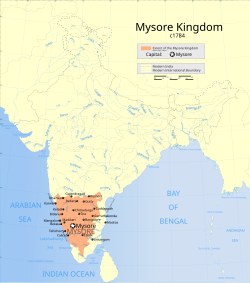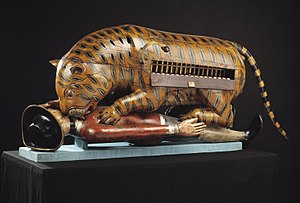
Back مملكة ميسور Arabic Maysur əmirliyi Azerbaijani میسور شاهلیغی AZB Майсор Bulgarian मैसूर राज Bihari মহীশূর রাজ্য Bengali/Bangla Rouantelezh Maisor Breton Regne de Mysore Catalan Maisúrské království Czech Kongeriget Mysore Danish
Kingdom of Mysore | |||||||||
|---|---|---|---|---|---|---|---|---|---|
| 1399–1950 | |||||||||
| Anthem: "ಕಾಯೌ ಶ್ರೀ ಗೌರಿ" "Kayou Sri Gowri" (1868–1950) (English: "Great Gowri") | |||||||||
 The Kingdom of Mysore during the reign of Tipu Sultan, 1784 AD (at its greatest extent) | |||||||||
| Status | Kingdom (Subordinate to Vijayanagara Empire until 1565) under a subsidiary alliance with the British Crown from 1799 Princely state under the British Crown from 1831 | ||||||||
| Capital | Mysore, Srirangapatna | ||||||||
| Official languages | Kannada, Persian | ||||||||
| Religion | Hinduism, Islam | ||||||||
| Demonym(s) | Mysoreans | ||||||||
| Government | Monarchy | ||||||||
| Maharaja | |||||||||
• 1399–1423 (first) | Yaduraya Wodeyar | ||||||||
• 1940–1950 (last) | Jayachamaraja Wodeyar | ||||||||
| Diwan | |||||||||
• 1782–1811 (first) | Purnaiah | ||||||||
• 1946–1949 (last) | Arcot Ramasamy Mudaliar | ||||||||
| History | |||||||||
• Established | 1399 | ||||||||
• Earliest records | 1551 | ||||||||
| 1767–1799 | |||||||||
| 1759–1787 | |||||||||
• Disestablished | 1950 | ||||||||
| |||||||||
| Today part of | India | ||||||||
The Kingdom of Mysore was a realm in the southern part of Deccan Plateau (modern-day South India) traditionally believed to have been founded in 1399 by two Hindu brothers (claiming Yadava descent), in the vicinity of the modern city of Mysore. From 1799 until 1950, it was a princely state, until 1947 in a subsidiary alliance with British India. The British took direct control over the princely state in 1831.[1] Upon accession to the Dominion of India, it became Mysore State, later uniting with other Kannada speaking regions to form the state of Karnataka, with its ruler remaining as Rajapramukh until 1956, when he became the first governor of the reformed state.
The kingdom, which was founded and ruled for the most part by the Hindu Wodeyar family, initially served as feudatories under the Vijayanagara Empire.[2] The 17th century saw a steady expansion of its territory and during the rule of Narasaraja Wodeyar I and Chikka Devaraja Wodeyar, the kingdom annexed large expanses of what is now southern Karnataka and parts of Tamil Nadu to become a powerful state in the southern Deccan. During a brief Muslim rule, the kingdom shifted to a Sultanate style of administration under Hyder Ali and Tipu Sultan, and was renamed the "Sultanat-e-Khudadad", translating into "The God gifted empire".[3][4]

During this time, it came into conflict with the Marathas, the Nizam of Hyderabad, the Kingdom of Travancore and the British, which culminated in the four Anglo-Mysore Wars. Success in the First Anglo-Mysore war and stalemate in the Second was followed by defeats in the Third and the Fourth. Following Tipu Sultan's death in the fourth war in the Siege of Seringapatam (1799), large parts of his kingdom were annexed by the British, which signalled the end of a period of Mysorean hegemony over South India. The British restored the Wodeyars to their throne by way of a subsidiary alliance and the diminished Mysore was transformed into a princely state. The Wodeyars continued to rule the state until Indian independence in 1947, when Mysore acceded to the Union of India.
Even as a princely state, Mysore came to be counted among the more developed and urbanised regions of South Asia. This period (1799–1947) also saw Mysore emerge as one of the important centres of art and culture in India. The Mysore kings were not only accomplished exponents of the fine arts and men of letters, they were enthusiastic patrons as well. Their legacies continue to influence music and the arts even today, as well as rocket science with the use of Mysorean rockets.[5]
- ^ Rajakaryaprasakta Rao Bahadur (1936), pg. 383
- ^ "Raja Wodeyar's Conquest of Srirangapatna". 26 March 2018. Archived from the original on 6 December 2022. Retrieved 6 December 2022.
- ^ Yazdani, Kaveh (2017), India, Modernity and the Great Divergence: Mysore and Gujarat (17th to 19th C.), Brill Publisher, p. 115, ISBN 9789004330795
- ^ Simmons, Caleb (2020), Devotional Sovereignty: Kingship and Religion in India, Oxford University Press, pp. 10–12, ISBN 9780190088897
- ^ Roddam Narasimha (May 1985). Rockets in Mysore and Britain, 1750–1850 A.D. Archived 27 September 2007 at the Wayback Machine. Published by the National Aeronautical Laboratory.
© MMXXIII Rich X Search. We shall prevail. All rights reserved. Rich X Search


